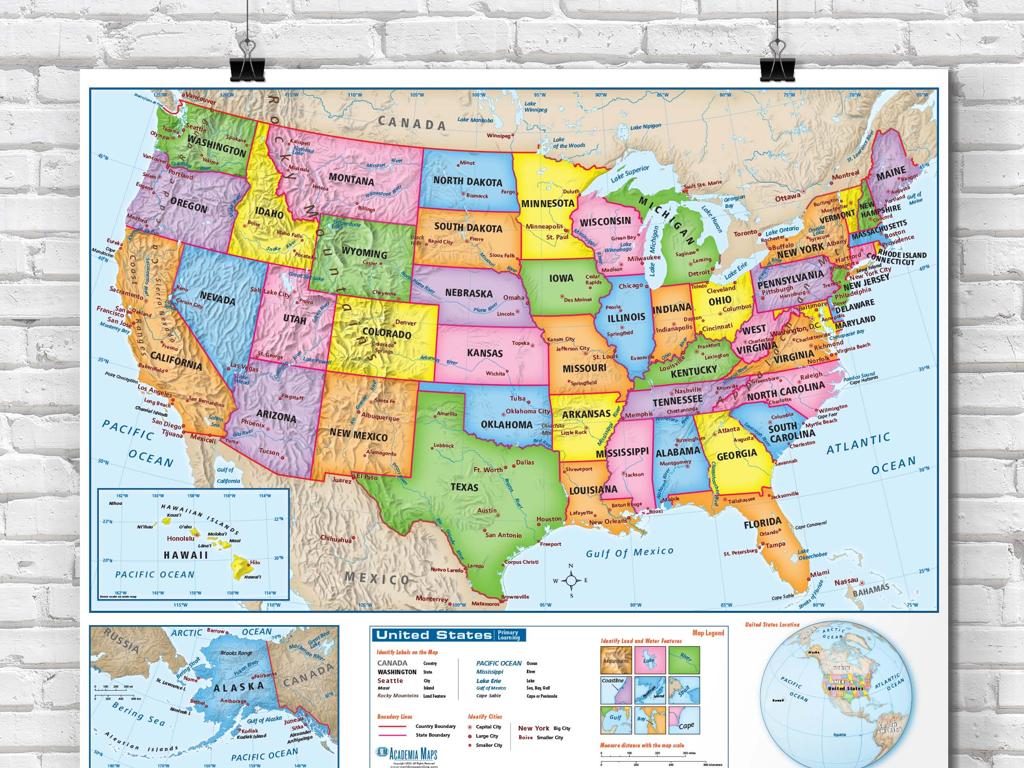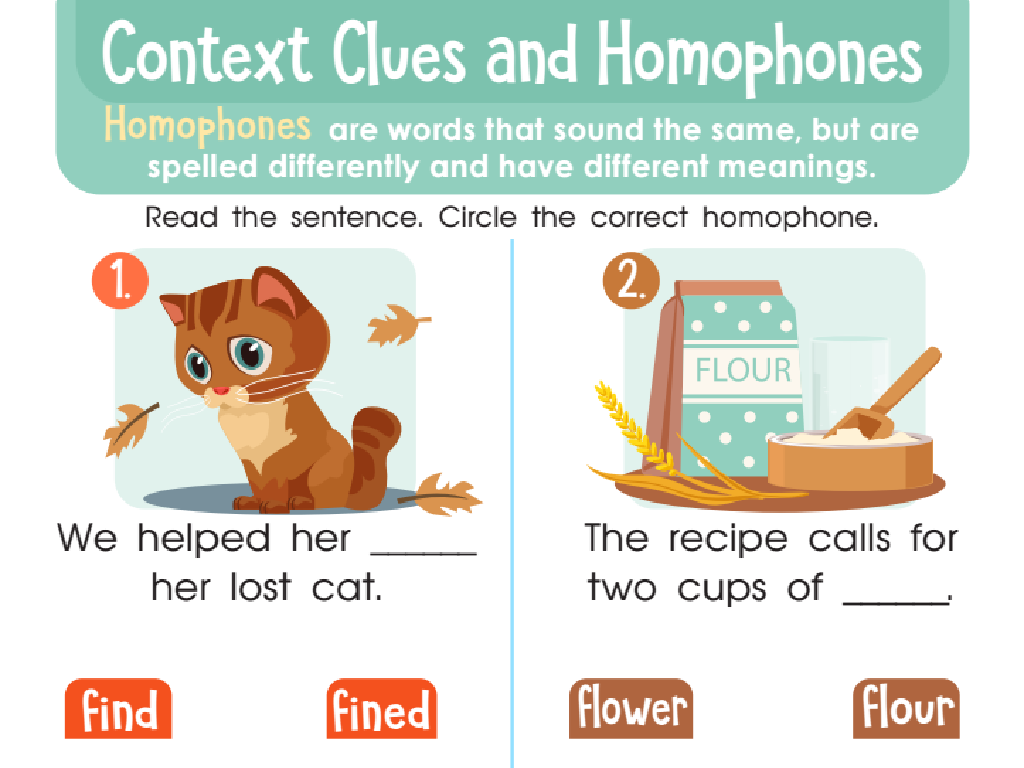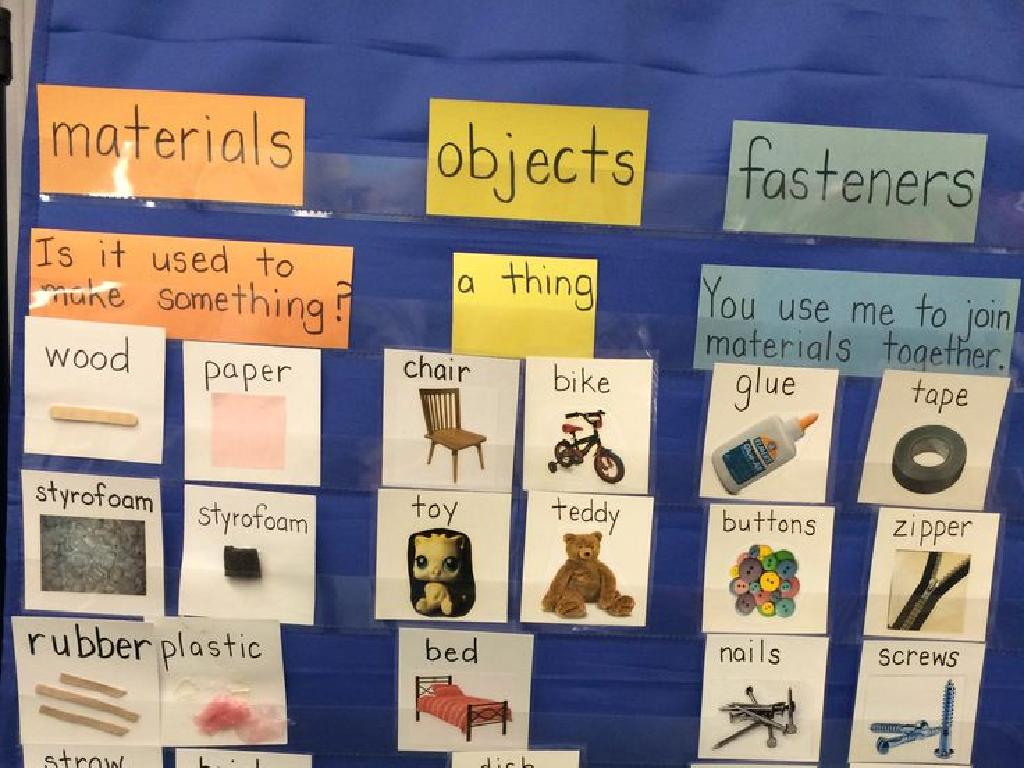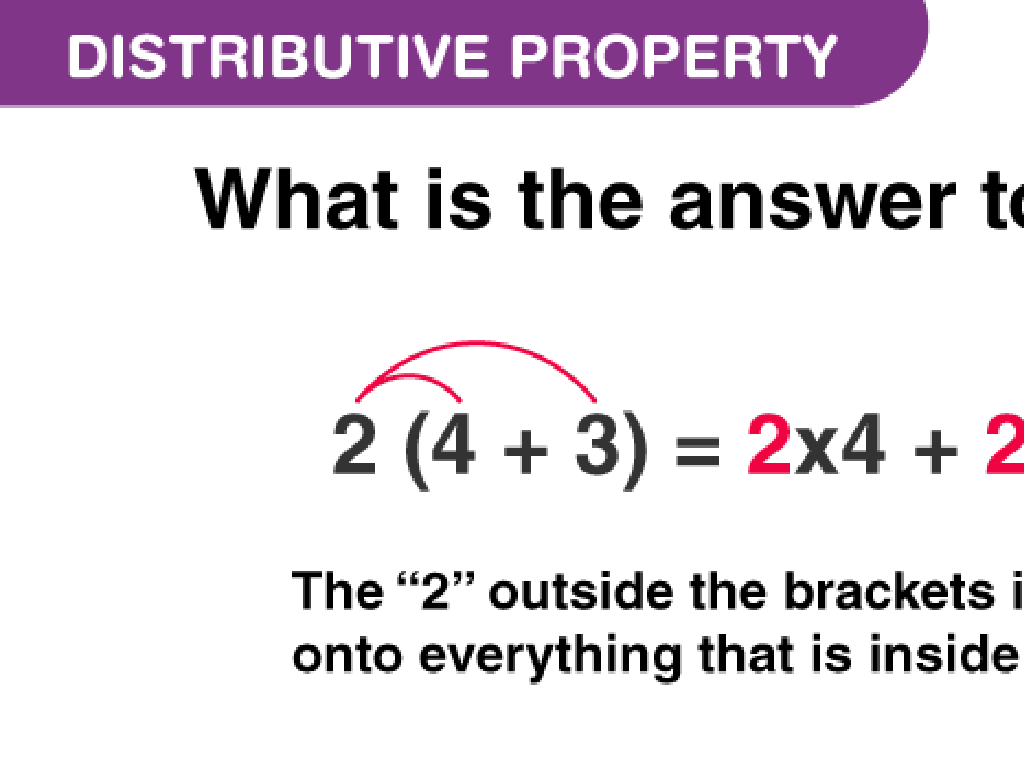Write The Addition Sentence - Up To Three Digits
Subject: Math
Grade: Second grade
Topic: Addition: Three Digits
Please LOG IN to download the presentation. Access is available to registered users only.
View More Content
Welcome to Addition: Big Numbers!
– Learning to add big numbers
– Writing 3-digit addition sentences
– An addition sentence for 123 + 456 looks like this!
– Practice with examples
– Example: 123 + 234 = ? Let’s find out together.
– Solve large addition problems
– You’ll be able to add numbers like 789 + 123 soon!
|
This slide introduces second-grade students to the concept of adding larger numbers, specifically up to three digits. Start by explaining that just like adding smaller numbers, adding big numbers follows the same principles but may require a bit more attention to detail. Use the board or interactive tools to demonstrate how to write an addition sentence with three-digit numbers. Provide clear examples and work through them step by step, ensuring to align the digits correctly by place value. Encourage students to practice with you, and reassure them that with practice, they’ll be able to tackle larger addition problems with confidence. Prepare to offer additional examples and hands-on activities where students can apply what they’ve learned.
Understanding Addition Sentences
– What is an addition sentence?
– It shows combining numbers together
– Parts of an addition sentence
– Numbers, a plus sign (+), and equals sign (=)
– Example: 123 + 456 = ?
– Let’s solve 123 + 456 together
– Writing our own addition sentences
– Practice by creating sentences with 3-digit numbers
|
This slide introduces the concept of addition sentences to second-grade students. An addition sentence is a mathematical expression that shows how two or more numbers are combined into a sum. It’s important to highlight the components of an addition sentence: the numbers being added (addends), the plus sign indicating addition, and the equals sign leading to the result. Use the example provided to walk through the process of adding two three-digit numbers step by step. Encourage students to think of their own examples and write them down. As an activity, students can pair up and create addition sentences for their partners to solve, fostering a collaborative learning environment.
Understanding Place Value
– Place value basics
Each number sits in a ‘place’ that has value.
– Digits and their places
Hundreds, tens, ones – each digit has a spot.
– Review with a fun video
– Practice place value
Let’s try some examples together after the video!
|
This slide introduces the concept of place value, which is essential for understanding how to add numbers up to three digits. Start by explaining that each digit in a number has a specific place and that place determines its value. Use visual aids like blocks or charts to show the hundreds, tens, and ones places. The video should be engaging and age-appropriate, ensuring that it reinforces the concept of place value in a fun and memorable way. After the video, engage the students with hands-on practice, using examples to solidify their understanding. This foundational knowledge will help them grasp addition of larger numbers in subsequent lessons.
Let’s Practice Place Value
– Understand each digit’s value
– Use blocks or drawings
– Visual aids for representing numbers
– Example: Number 123
– Shows 1 hundred block, 2 ten rods, 3 unit cubes
– Breakdown: 1 hundred, 2 tens, 3 ones
– Helps grasp the concept of place value
|
This slide is aimed at helping second-grade students understand the concept of place value in three-digit numbers. By using blocks or drawings, students can visually represent the value of each digit in a number. For example, the number 123 is broken down into 1 hundred, 2 tens, and 3 ones. This visual representation reinforces the value of each place and helps students better understand how to construct and deconstruct numbers. During the class activity, encourage students to use physical blocks or draw their representations to solidify their understanding. Provide several examples and allow students to practice with different numbers to ensure they grasp the concept.
Writing Addition Sentences: 3-Digit Numbers
– Start with the ones place
– Begin adding from the rightmost column
– Line up numbers by place value
– Ensure each digit is in the correct column: ones, tens, hundreds
– Carry over extra tens
– If a column adds up to 10 or more, carry over to the next column
– Practice with examples
– Use example: 123 + 456. Add ones, carry tens, then hundreds
|
This slide introduces students to the process of writing addition sentences for three-digit numbers. Emphasize the importance of starting from the ones place and moving left, as this is the foundation of addition. Make sure students understand how to line up numbers by their place values, which is crucial for maintaining accuracy. Demonstrate carrying over tens with clear examples, and provide practice problems for students to apply these concepts. Encourage them to use scratch paper to line up their numbers correctly and to check their work by adding multiple times.
Example Time: Adding Three-Digit Numbers
– Solve 234 + 156 together
– Add step by step on the board
– Learn to carry over tens
– When a column adds up to 10 or more, we carry over to the next column.
– Understand place value in addition
– Each digit has a place value: ones, tens, hundreds.
|
This slide is designed to walk second-grade students through the process of adding three-digit numbers. Start by writing the numbers 234 and 156 on the board, ensuring they are aligned by place value columns (ones, tens, hundreds). Demonstrate adding each column, starting from the ones place. Emphasize the concept of carrying over when a column’s sum exceeds 9, moving the extra value to the next column on the left. This will help students understand the importance of place value in addition. Encourage students to ask questions and try their own examples after the demonstration. Provide additional examples with varying levels of difficulty for students to practice carrying over.
Your Turn to Try: Adding Three-Digit Numbers
– Write your own addition sentence
– Try adding 321 + 432
– Example: 321 (top) + 432 (bottom)
– Line up the numbers correctly
– Place hundreds, tens, and ones under each other
– Remember to carry over
– If a column adds up to 10 or more, carry over to the next column
|
This slide is an interactive activity for students to practice adding three-digit numbers. Encourage them to write the numbers in columns, aligning the hundreds, tens, and ones places. Remind them to start adding from the rightmost column (ones) and move left, carrying over to the next column when the sum exceeds 9. This exercise will help reinforce their understanding of place value and the addition process. Prepare to assist students who may struggle with the concept of carrying over and ensure that they understand each step before moving on to the next.
Class Activity: Addition Relay
– Teams solve addition problems
– Each member adds one number
– Pass the problem to the next person
– First team to finish wins!
|
This activity is designed to encourage teamwork and practice addition skills with up to three-digit numbers. Divide the class into small groups, each group being a team. Provide each team with a set of addition problems that require adding three numbers together. Each student in the team adds one number to the problem and then passes it to the next team member to add the next number. The process continues until the last member adds the final number and the team checks their answer. The first team to correctly complete all their problems wins. Make sure to prepare different sets of problems for each team to prevent copying and to cater to varying levels of difficulty for different groups. This activity will help students to work collaboratively and reinforce their addition skills in a fun and competitive way.
Celebrating Addition Mastery!
– Congratulations on learning addition!
– Practice at home to become an addition star
– Try adding numbers from books or toys
– Get ready for subtraction adventures
– We’ll explore taking away numbers next
– Keep up the great work!
|
This slide is meant to congratulate the students on their hard work learning to write addition sentences with up to three digits. Encourage them to continue practicing at home using everyday items to reinforce their skills. Let them know that their next mathematical journey will involve learning subtraction with large numbers. Provide some tips for parents to help their children practice, such as using board games with numbers or adding up items during grocery shopping. Remind the students that practice is key to becoming confident in math, and their efforts are building a strong foundation for future math concepts.






